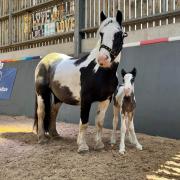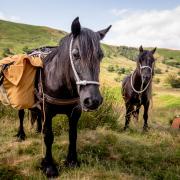Anthony Ratcliffe is a dedicated fell runner but he also uses the landscape to create fascinating images, writes Barbara Waite.

It probably helps that Anthony Ratcliffe is a very fit man for he loves to explore the remote countryside, documenting the effects of industry on the hills.
He has competed in many fell races in the north of England particularly in Lancashire and Cumbria, completing the Bob Graham Round in fewer than 20 hours and breaking the record for ‘The Fellsman’ in 1991 – 61 miles in 10 hours and 11 minutes.
Anthony’s artistic relationship with landscape has always been enhanced by years of involvement with climbing and running and he lives and works from a studio in Mossley near spectacular Saddleworth Moor.
The landscape images in his prints are developed from sketchbook drawings made on site and enriched by further research into historical recordings of topographical and archeological features found in the remoter areas of not just the uplands but the coastline as well.

He is interested in the remnants left by industrial intrusion into the hills and how they become integral parts of the character of that particular landscape.
Anthony is now a full-time printmaker after retiring from a senior lecturer post at Manchester School of Art and he will be taking part in PrintFest 2018 in Ulverston’s Coronation Hall on May 5 & 6.
The source of any image is usually a result of exploring the more remote areas of Britain and collecting drawn information as well as photography. Then, he uses his extensive collection of maps, guidebooks and literature associated with the area to develop his ideas into a composition which is translated into a series of pen and ink studies.
These are enlarged, reversed (the print process inverts the image) and redrawn onto a woodblock using charcoal and then poster paint. ‘This image is then cut out using a craft knife and tools. The different tones of the ink drawing are translated by scratching and making patterns and cut marks,’ said Anthony.

‘This first block is then printed onto a piece of transparent acetate to create an overlay with the image on it. A second block is now reduction printed using the acetate as a guide to trace and cut out parts of the surface. This reduction process is repeated until a patchwork of background colours are completed.
‘The original block is then inked up in a dark colour and carefully overprinted onto the background colours of each edition copy. The editions are small due to the elaborate and time consuming process.
‘All the printing is done by hand using a spoon to burnish the back of the paper. The process is irreversible and the size of the edition has to be decided at the outset. Each print is as identical as possible.’
He has created numerous collections of work associated with aspects of the British landscape. His current project is entitled ‘Northern Stones and Peat Smoke’ which is to be exhibited next year at the Kirby Gallery in Liverpool.
Past projects exhibited in provincial northern galleries such as ‘Broken Ground’, ‘Shoreline and Watershed’, Rain Stone and Rust’ have included book art, watercolour studies and poetry as well as large woodcut prints.
He has a busy exhibition programme and is currently involved in up to ten a year, and he also runs workshops usually associated with the bigger exhibitions.
His commissioned prints can be found in many private and corporate collections such as Manchester Airport, the Parliamentary Art Collection and the British Council.
Despite a busy artistic schedule he still finds time to run most days on the local fells and while seeking out new inspiring subjects he is very close to completing ascents of all the 288 Scottish Munros.
See more on his website: anthonyratcliffe.co.uk



























